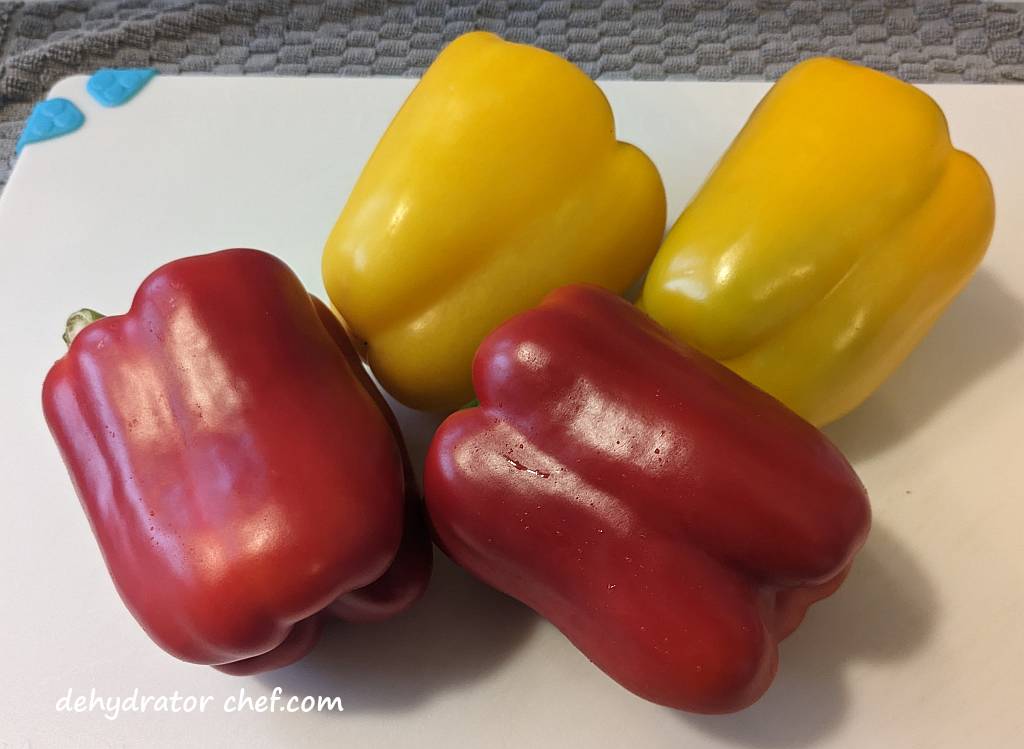In this section, we are going to cover how to choose the best vegetables to dehydrate. We will provide an overview of selecting suitable vegetables for dehydration. By selecting vegetables your family enjoys, you can enjoy delicious and nutritious dehydrated ingredients for your camping trips, hiking excursions, or as a part of your food preparedness plan. Let’s jump into the details and discover how to choose the perfect vegetables for dehydration.
Table of Contents
- Choosing the Best Vegetables to Dehydrate
- What to Consider When Choosing the Best Vegetables to Dehydrate
- Summary
Choosing the Best Vegetables to Dehydrate
Most vegetables are well-suited for dehydration, offering excellent flavor, texture, and nutritional value in their dried form. Consider starting with these vegetables in your dehydration projects:

- Bell peppers: Bell peppers add vibrant color and a sweet, tangy flavor to your dehydrated recipes. Properly prepared, bell peppers will easily and quickly reconstitute with other dehydrated meal ingredients. They are versatile and can be used in many dehydrated meal plans, including supplementing store-bought prepackaged freeze-dried meals.
- Cabbage: Dehydrated cabbage can be used in many ways. We do like our unstuffed cabbage roll recipe.
- Jalapeno peppers: Dehydrated jalapeno peppers add a spicy kick to your recipes.
- Poblano peppers: Poblano peppers, when dehydrated, offer a smoky and mildly spicy flavor.
- Onions: Dehydrated onions are a must-have for homemade dehydrated meals. They are great for seasoning soups, sauces, and casseroles.
- Tomatoes: Dehydrated tomatoes are bursting with intense flavor, making them perfect for adding to pasta dishes, sandwiches or rehydrating for use in sauces and salsas.
- Leeks: Dehydrated leeks contribute a mild onion-like flavor to dishes.
- Shallots: Dehydrated shallots offer a delicate and slightly sweet flavor.
- Scallions: Dehydrated scallions provide a mild onion flavor.
- Potatoes: Dehydrated potatoes can be rehydrated for use in soups, stews, or casseroles.
- Brussels sprouts: Dehydrated Brussels sprouts offer a unique flavor and can be added to many dehydrated meals.
- Cauliflower: Dehydrated cauliflower can be used in soups, stews, or as a rice substitute in low-carb dishes.
- Celery: Dehydrated celery adds a mild, earthy flavor to recipes. It can be used in soups, stews, or as a seasoning.
- Greens: Various greens, such as kale, spinach, or Swiss chard, can be dehydrated and used in soups, or powdered and included in smoothies and other recipes.
- Radishes: Dehydrated radishes offer a slightly peppery and crunchy texture. They can be used as trail snacks or in trail mixes.
Remember, it’s essential to dehydrate vegetables that you and your family enjoy. This way, you can compare the taste and texture of your favorite fresh produce to the reconstituted vegetables you have dehydrated.
What to Consider When Choosing the Best Vegetables to Dehydrate
When selecting vegetables for dehydration, consider the following factors:
- Ripeness: Choosing vegetables that are at their peak ripeness is always a good idea. They should be firm and free from blemishes or bruises. Local farmers’ markets are a good source for finding what is in season.
- Quality: Opt for high-quality vegetables that are fresh and free from signs of decay if you can find it, don’t sweat it if you can’t. Quality produce will result in better flavor and texture in the dehydrated form. But don’t overlook less-than-perfect produce. Way too much gets thrown away because of a blemish or other minor imperfection.
- What’s on Sale: Take advantage of sales or discounts on vegetables to save money.
- Availability: Use vegetables that are readily available in your area or garden.
- Bulk Dehydration: Utilize all available space in the food dehydrator for efficient and productive use of your time.
- Flavor profiles: Experiment with a variety of vegetables to add diversity to your dehydrated meals.
Summary
Selecting suitable vegetables is a crucial step in successful dehydration. Consider including bell peppers, cabbage, jalapeno peppers, poblano peppers, onions, tomatoes, leeks, shallots, scallions, potatoes, Brussels sprouts, cauliflower, celery, greens, and radishes in your dehydrating adventures. Consider factors like ripeness, quality, what’s on sale, and availability when making your selection. By following these guidelines, you’ll be well on your way to enjoying the benefits of dehydrated vegetables for camping, hiking, reducing food waste, stocking the pantry, and food preparedness.
Previous: How to Dehydrate Vegetables 101: A Beginner’s Guide on How to Dehydrate and Store Vegetables
Next: Dehydrating Vegetables for Storage: A Beginner’s Guide on How to Dehydrate and Store Vegetables
